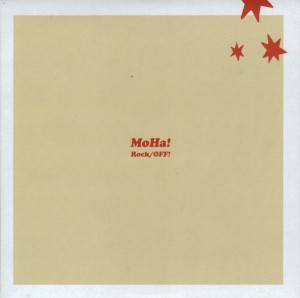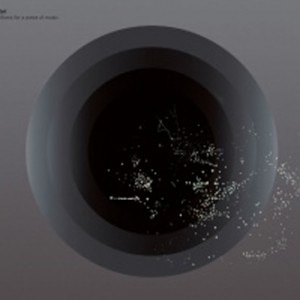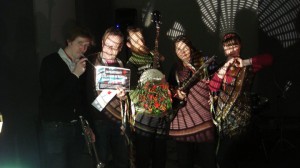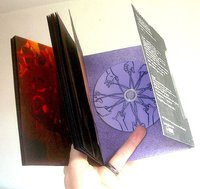Wit vinyl, 7”. MoHa! – Olsen & Hana. Kant 1 in trash-pop-punk-rock ‘mode’ met zang, kant 2 impro-trash-noise met John Hegre als gast. 2006. Love the energy, speelplezier knalt ervan af. Niet bij te werken, goed als opkikker.

http://www.n-collective.com/files/moha2.html
(Hun eigen discografie vermeldt deze single niet).
Rood vinyl, uitgegeven in het kader van Radio Rood (2010) een conceptueel project van Moritz Ebinger over de betekenis van de kleur rood. Ik kreeg een exemplaar omdat Oorbeek in zijn programma zat, er staat een kort stukje van ons op de plaat (bezetting zo te horen drums, bas en zang plus effecten van Mark). (Afkomstig van studio-opnames voor een tweede CD, die er nooit is gekomen omdat we het over geen enkele track eens konden worden). Kan er nu eindelijk naar luisteren.
Het lastige bij dit soort platen is dat er vanalles op staat wat interessant is, veel gesproken woord en muziek die mijn aandacht niet kan vasthouden. Dan is het ineens lastig dat je bij vinyl niet met een drup op de knop een track kunt skippen of doorspoelen. Het vinyl ziet er prachtig uit, maar ik vrees dat ik de naald niet door de hele groef heb laten draaien.
http://www.radiorood.nl/
Sinds 1 februari heb ik 30 m2 ruimte extra: een werkplaats, een atelier, een studeerplek. Ongeveer de helft van mijn spullen verhuis ik in de komende tijd daarheen, boeken, gitaren, fietsen. In mijn werkkamer thuis – die dubbelt als logeer- en soms slaapkamer – gaan we een kamer voor R. bouwen. Het geeft me de gelegenheid om voor het eerst sinds jaren weer een platenspeler aan te sluiten op een versterker en luidsprekers. Ik ben van plan om door mijn platenverzameling heen te luisteren. Een echte verzameling kun je het niet noemen. Ik nam cassettebandjes op, ik heb nooit veel platen gekocht. Mijn ‘verzameling’ bestaat vooral uit wat goedkope en tweedehands jazz (bebop, hardbop, freejazz, Coltrane), aangevuld met wat meer rock-georienteerde avant-garde, en een klein beetje klassiek.
Het meest recent gekochte vinyl is hedendaags, een paar dingen van Morten Olsen. Zoals de eerste LP die ik oplegde: conditions for a piece of music van ultralyd (Olsen, Brandsdal, Hana, Moster) uit 2007. Voor zover ik weet allemaal doorgecomponeerde stukken, met een Feldmaneske benadering van het geluid, uitgerekt, trage tempo’s, lage bas, sustain. Olsen speelt behalve de drumkit veel vibraphone. Het materiaal is te vergelijken met dat van de drone rock, Stephen O’Malley-like, maar de uitvoering is ingehouden, en, tja, op structuur gericht (wat sfeer oplevert) in plaats van op het opwekken van een sfeer door een overload aan geluid.
Live was ultralyd overigens wel heel luid en hard. Zeker op die ene avond toen KTL (Pita & O’Malley) na hen speelde.
Ik vind de LP conditions for a piece of music ook vandaag nog altijd geslaagd en erg mooi en heb het idee dat in het terrein dat Ultralyd hier betreedt nog veel te ontdekken valt. Het is muziek die mij na aan het hart gaat. (De beschrijving op de site van Rune Grammofone meldt dat het lijkt op King Crimson anno 1973 – hmm. Not for me).

http://www.runegrammofon.com/artists/ultralyd/rcd-2065—ultralyd-conditions/
http://boomkat.com/cds/35185-ultralyd-conditions-for-a-piece-of-music
Het gebeurt niet vaak, bij de hoeveelheden gigabytes mp3s en flacs die binnenstromen in het ‘download’-mapje, en vervolgens één keer worden beluisterd (als ze al worden beluisterd), dat je aandacht vol gepakt wordt door wat je hoort. Veel luisterwerk is inderdaad ‘werk’, ‘afluisteren’, ‘uitchecken’, ‘leren kennen’.
De 10 CD box Musica Improvvisa, met recente geïmproviseerde muziek uit Italië, uitgegeven door het onvolprezen Die Schachtel, pakte me, en ik luister er nu herhaaldelijk naar. Slechts één naam kende ik (Domenico Sciajno – oké, en Gene Coleman en Hans Koch maar dat zijn geen Italianen). Het meeste valt binnen gekende kaders van de hedendaagse geïmproviseerde en elektro-akoestische muziek, instrument+laptop, vaak zacht, op textuur gespeeld, met veel reminiscenties aan AMM en Nuova Consonanza, maar het is allemaal zeer geconcentreerd en precies. AMP en Ligatura zijn voor mij de hoogtepunten.
Overigens kost de box slechts 50 euro, en is de oplage 500. Er zit ook nog een DVD bij. I feel tempted & obliged.

http://www.dieschachtel.com/editions/DSIMP1.html
Eergisteren keek ik de documentaire over Bela Fleck’s reis naar Afrika, Throw down your Heart. Het idee: bringing the banjo back to Africa. De banjo is een karakteristiek blank instrument geworden, instrument van de arme blanken uit de Appalachen, van Ierse muziek. Het was in de negentiende eeuw een instrument van de zwarte bevolking, en de roots van de banjo – en de drone-snaar – liggen in Afrika.
Ik speel zelf een beetje banjo. Niet erg goed. Ik ben autodidact gitarist en heb anderhalf jaar geleden een Ierse banjo gekocht – een viersnarige. (Van die vijfde snaar raak ik helemaal in de war). Ik speel ‘m gestemd in kwinten (AEbfis), deels om mezelf te dwingen een eigen stijl te ontwikkelen – hoe primitief ook – in plaats van mezelf de druk op te leggen redelijk correct clawhammer of Earl Scruggs-style te leren spelen.
Bela Fleck is een fantastische banjoist, maar ik heb zijn spel altijd wat saai gevonden. Kijkend naar de documentaire – die verrassend weinig blijkt te gaan over de Afrikaanse roots van de banjo en veel meer over Bela Fleck die meespeelt met verschillende Afrikaanse musici – begreep ik waarom.
Het ligt aan de speeltechniek van Fleck. Hij speelt altijd met drie picks, bluegrass-stijl, en benadert de banjo alsof het een gitaar is. Hij soleert harmonisch afwisselend, dat is ‘innovatief’. In de documentaire valt op dat hij de vijfde snaar nauwelijks gebruikt. De banjo is niet zo’n geschikt instrument om harmonisch complex op te soleren, wie dat wel doet, in een vlekkeloze techniek, is een fantastisch banjoist.
Voor mij is de banjo een fascinerend instrument vanwege de percussieve kwaliteiten, vanwege de effecten van de verschillende aanslagen (clawhammer techniek, verschil tussen up- en downstroke, nagel of vinger), vanwege de vreemde resonantie, de klank van de drones. Zulke aspecten zijn vrijwel afwezig in het spel van Bela Fleck, spelen nooit een hoofdrol.
De documentaire is overigens heel kijkbaar: http://www.throwdownyourheart.com/.
Sinds de sluiting van PostCS oefent Oorbeek in de Muzyq – het nieuwe ‘muziekmakerscentrum’ in Amsterdam-Oost waarover het afgelopen jaar nogal wat te doen is geweest. Prachtige oefenruimtes en voor de meeste van ons een perfecte locatie. We komen er sinds nazomer 2009, nog voor de offciele opening.
Gisteren oefenden we van 9 – 12 ‘s avonds. Guess what. Wij hadden reservering numero 15.000 gemaakt, en we werden getrakteerd op bloemen, foto’s en 10x gratis oefenen.

Volgende week een optreden: Serge Onnen’s Ombromanie, vier uur lang op donderdag 3 februari tijdens het Filmfestival Rotterdam, van 20.00 – 0.00.
http://www.muzyq.nl
http://www.filmfestivalrotterdam.com/nl/films/parental-guidance-serge-onnen-ombromanie/
http://www.oorbeek.net
Nieuw tijdschrift over hedendaagse compositie: The Ear Reader. Ziet er erg goed uit, zin om al die essays te lezen en Kyriakides & Vigier’s Queer Foreign Objects te spelen. Goed werk van Rozalie Hirs & anderen.
A really late announcement, in two hours from now Oorbeek will do an acoustic concert to celebrate the release of the Ombromanie dvd & book, at the Soon Institute, Vijzelstraat 67, Amsterdam: http://www.thesooninstitute.com/tmc/. That is Wednesday December 15th, 18 – 20 hrs.

From the Facebookpage (I don’t do Facebook):
“Very limited edition book & dvd with 16mm, 8mm, video registrations of oorbeek shadow performances in Amsterdam and Berlin.
small party with accidental music, ignored drinks, projections”
Thursday, that is tomorrow, the Sonic Acts Festival will kick off with a day long session at STEIM, and then really with the opening at NIMk, followed by performances in Paradiso, and then on Friday, the start of the conference.
There are still tickets for the evening programmes on Thursday, Friday and Saturday. Only the conference and the Planetarium on Sunday are sold out. So, you can all still get out there and see & hear for instance Streifenjunko & Keith Rowe on Thursday, or Expanded Cinema on Friday (like Paul Sharits and Lis Rhodes and Bruce McClure), or Gilles Aubry, Eric La Casa, Hildegard Westerkamp, Jacob Kirkegaard and others on Saturday: http://www.sonicacts.com.
For all of you in the Netherlands – today in the Cultureel Supplement, a long article on the coming Sonic Acts Festival: http://weblogs.nrc.nl/cultuurblog/2010/02/12/cs-sonic-acts-beeld-en-ruimte/.




